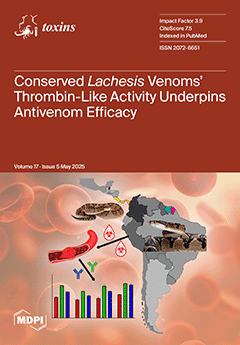The emergence of antimicrobial resistance is a significant challenge in global healthcare, necessitating innovative techniques to address multidrug-resistant pathogens. Multidrug-resistant pathogens like
Klebsiella pneumoniae,
Acinetobacter baumannii, and
Pseudomonas aeruginosa pose significant public health threats, as they are increasingly resistant to common
[...] Read more.
The emergence of antimicrobial resistance is a significant challenge in global healthcare, necessitating innovative techniques to address multidrug-resistant pathogens. Multidrug-resistant pathogens like
Klebsiella pneumoniae,
Acinetobacter baumannii, and
Pseudomonas aeruginosa pose significant public health threats, as they are increasingly resistant to common antibiotics, leading to more severe and difficult-to-treat infections. These pathogens are part of the ESKAPE group, which includes
Enterococcus faecium,
Staphylococcus aureus, and
Enterobacter species. Animal venoms, derived from a wide range of species such as snakes, scorpions, spiders, bees, wasps, and ants, represent a rich source of bioactive peptides. Venoms have been a valuable source for drug discovery, providing unique compounds with therapeutic potential. Venom-derived drugs are known for their increased bioactivity, specificity, and stability compared to synthetic alternatives. These compounds are being investigated for various conditions, including treatments for diabetes, pain relief, cancer, and infections, showcasing their remarkable antimicrobial efficacy. In this review, we provide a comprehensive investigation into the potential of venom-derived compounds for developing new antimicrobial agents, including antibacterial, antifungal, antiviral, and antiparasitic therapeutics. Key venom components, including melittin from bee venom, phospholipase A
2 from snake venom, and chlorotoxin from scorpion venom, exhibit potent antimicrobial effects through mechanisms such as membrane disruption, enzymatic inhibition, and immune modulation. We also explore the challenges related to the development and clinical use of venom-derived antimicrobials, including toxicity, stability, and delivery mechanisms. These compounds hold immense promise as transformative tools against resistant pathogens, offering a unique avenue for groundbreaking advancements in antimicrobial research and therapeutic development.
Full article






